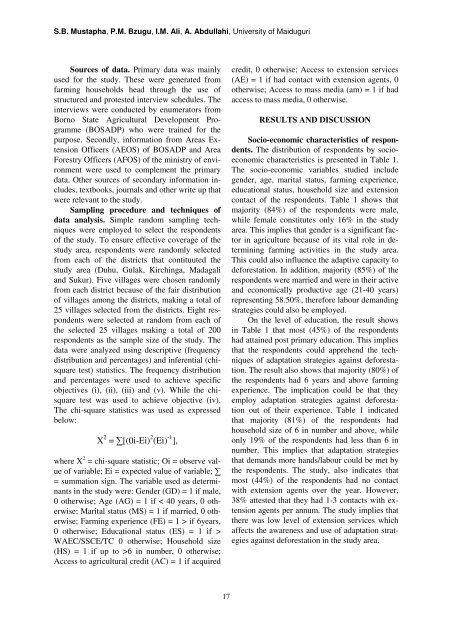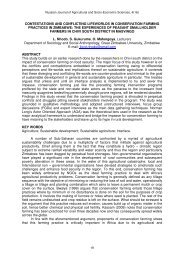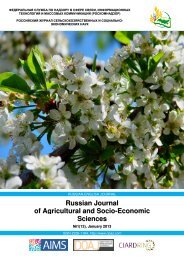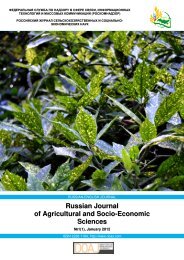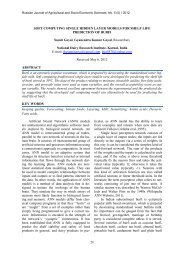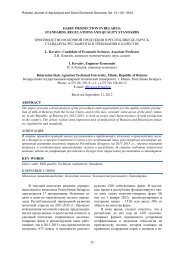Russian Journal of Agricultural and Socio-Economic Sciences ...
Russian Journal of Agricultural and Socio-Economic Sciences ...
Russian Journal of Agricultural and Socio-Economic Sciences ...
You also want an ePaper? Increase the reach of your titles
YUMPU automatically turns print PDFs into web optimized ePapers that Google loves.
S.B. Mustapha, P.M. Bzugu, I.M. Ali, A. Abdullahi, University <strong>of</strong> MaiduguriSources <strong>of</strong> data. Primary data was mainlyused for the study. These were generated fromfarming households head through the use <strong>of</strong>structured <strong>and</strong> protested interview schedules. Theinterviews were conducted by enumerators fromBorno State <strong>Agricultural</strong> Development Programme(BOSADP) who were trained for thepurpose. Secondly, information from Areas ExtensionOfficers (AEOS) <strong>of</strong> BOSADP <strong>and</strong> AreaForestry Officers (AFOS) <strong>of</strong> the ministry <strong>of</strong> environmentwere used to complement the primarydata. Other sources <strong>of</strong> secondary information includes,textbooks, journals <strong>and</strong> other write up thatwere relevant to the study.Sampling procedure <strong>and</strong> techniques <strong>of</strong>data analysis. Simple r<strong>and</strong>om sampling techniqueswere employed to select the respondents<strong>of</strong> the study. To ensure effective coverage <strong>of</strong> thestudy area, respondents were r<strong>and</strong>omly selectedfrom each <strong>of</strong> the districts that contituuted thestudy area (Duhu, Gulak, Kirchinga, Madagali<strong>and</strong> Sukur). Five villages were chosen r<strong>and</strong>omlyfrom each district because <strong>of</strong> the fair distribution<strong>of</strong> villages among the districts, making a total <strong>of</strong>25 villages selected from the districts. Eight respondentswere selected at r<strong>and</strong>om from each <strong>of</strong>the selected 25 villages making a total <strong>of</strong> 200respondents as the sample size <strong>of</strong> the study. Thedata were analyzed using descriptive (frequencydistribution <strong>and</strong> percentages) <strong>and</strong> inferential (chisquaretest) statistics. The frequency distribution<strong>and</strong> percentages were used to achieve specificobjectives (i), (ii), (iii) <strong>and</strong> (v). While the chisquaretest was used to achieve objective (iv).The chi-square statistics was used as expressedbelow:X 2 = [(0i-Ei) 2 (Ei) -1 ],where X 2 = chi-square statistic; Oi = observe value<strong>of</strong> variable; Ei = expected value <strong>of</strong> variable; = summation sign. The variable used as determinantsin the study were: Gender (GD) = 1 if male,0 otherwise; Age (AG) = 1 if < 40 years, 0 otherwise;Marital status (MS) = 1 if married, 0 otherwise;Farming experience (FE) = 1 > if 6years,0 otherwise; Educational status (ES) = 1 if >WAEC/SSCE/TC 0 otherwise; Household size(HS) = 1 if up to >6 in number, 0 otherwise;Access to agricultural credit (AC) = 1 if acquiredcredit, 0 otherwise; Access to extension services(AE) = 1 if had contact with extension agents, 0otherwise; Access to mass media (am) = 1 if hadaccess to mass media, 0 otherwise.RESULTS AND DISCUSSION<strong>Socio</strong>-economic characteristics <strong>of</strong> respondents.The distribution <strong>of</strong> respondents by socioeconomiccharacteristics is presented in Table 1.The socio-economic variables studied includegender, age, marital status, farming experience,educational status, household size <strong>and</strong> extensioncontact <strong>of</strong> the respondents. Table 1 shows thatmajority (84%) <strong>of</strong> the respondents were male,while female constitutes only 16% in the studyarea. This implies that gender is a significant factorin agriculture because <strong>of</strong> its vital role in determiningfarming activities in the study area.This could also influence the adaptive capacity todeforestation. In addition, majority (85%) <strong>of</strong> therespondents were married <strong>and</strong> were in their active<strong>and</strong> economically productive age (21-40 years)representing 58.50%, therefore labour dem<strong>and</strong>ingstrategies could also be employed.On the level <strong>of</strong> education, the result showsin Table 1 that most (45%) <strong>of</strong> the respondentshad attained post primary education. This impliesthat the respondents could apprehend the techniques<strong>of</strong> adaptation strategies against deforestation.The result also shows that majority (80%) <strong>of</strong>the respondents had 6 years <strong>and</strong> above farmingexperience. The implication could be that theyemploy adaptation strategies against deforestationout <strong>of</strong> their experience. Table 1 indicatedthat majority (81%) <strong>of</strong> the respondents hadhousehold size <strong>of</strong> 6 in number <strong>and</strong> above, whileonly 19% <strong>of</strong> the respondents had less than 6 innumber. This implies that adaptation strategiesthat dem<strong>and</strong>s more h<strong>and</strong>s/labour could be met bythe respondents. The study, also indicates thatmost (44%) <strong>of</strong> the respondents had no contactwith extension agents over the year. However,38% attested that they had 1-3 contacts with extensionagents per annum. The study implies thatthere was low level <strong>of</strong> extension services whichaffects the awareness <strong>and</strong> use <strong>of</strong> adaptation strategiesagainst deforestation in the study area.17


